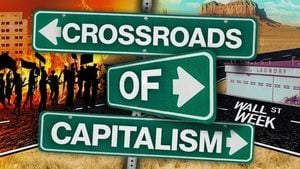The American job market has entered a period of extraordinary turbulence, with October 2025 standing out as a historic turning point marked by mass layoffs, rising automation, and a profound sense of uncertainty. According to a report released by Challenger, Gray & Christmas and cited by Reuters, U.S.-based employers slashed over 153,000 jobs in October, representing a staggering 175% increase compared to the same month last year. This marks the largest number of cuts for any October in more than two decades, a fact echoed by multiple sources including The Wall Street Journal and EdexLive.
Behind these numbers lies a complex web of causes. Analysts and economists point to a confluence of forces: the rapid adoption of artificial intelligence (AI), sweeping cost-cutting initiatives, rising tariffs, and a cooling of both consumer and corporate spending. Gregory Daco, chief economist at EY-Parthenon, observed, “Whether it’s due to softer final demand, rising input costs, or AI adoption, many companies are simply finding they can operate with fewer people.” The tech sector led the way in job cuts, with 33,000 positions eliminated in October alone—nearly six times the number from September—followed by significant reductions in retail and service industries.
The scale of the layoffs is not limited to a single month. From January through the end of October 2025, employers announced over 1.09 million job cuts, a 65% rise from the 664,839 reported during the same period in 2024. This ten-month total is the highest since the pandemic-ravaged year of 2020, as reported by The Wall Street Journal. The Challenger, Gray & Christmas report also noted that nearly 450 individual companies announced job cut plans in October, up from under 400 in September, signaling a broadening wave of workforce reductions.
Cost-cutting was cited as the primary driver for the October layoffs, but artificial intelligence was a close second. As companies increasingly invest in AI, many are reimagining their business models—often at the expense of human labor. The report cited by EdexLive highlighted that "the key drivers cited for the surge by the report are increased AI adoption and sweeping cost-cutting efforts across industries." This technological pivot is not just a matter of efficiency; it is reshaping the very fabric of employment and opportunity in America.
The consequences of this shift are visible in the changing dynamics of corporate power. According to reporting in Article 1, the top ten S&P 500 companies now control nearly 40% of the index’s total value, a concentration of corporate dominance unseen in modern history. This centralization reflects a broader societal divide, where wealth and opportunity cluster among a select few, while the majority of the workforce struggles to keep pace. Despite record profits, many corporations are operating with fewer workers, further eroding the traditional social contract that promised stability in exchange for education and effort.
“Some industries are correcting after the hiring boom of the pandemic, but this comes as AI adoption, softening consumer and corporate spending, and rising costs drive belt-tightening and hiring freezes,” explained Andy Challenger, chief revenue officer for Challenger, Gray & Christmas, as quoted by Reuters. The labor market’s cooling is evident not only in the layoffs but also in declining hiring activity. According to Bank of America’s analysis of customer-deposit data, while there has been no dramatic deterioration, hiring activity has been steadily declining since the spring of 2025. Job postings tracked by Indeed in late October fell to their lowest level since 2021, and LinkedIn reported a continued drop in hiring month over month.
Amid this uncertainty, the U.S. government shutdown that began on October 1, 2025, has added another layer of complexity. With official employment data releases suspended, economists, investors, and policymakers have been forced to rely on private-sector sources to piece together the true state of the labor market. This patchwork of data has left many guessing about the full extent of the downturn. “It’s cooling, but not collapsing,” said David Tinsley, senior economist at the Bank of America Institute. “The job market has clearly slowed from the highs of the past two years, but this isn’t a total breakdown, at least not yet.”
Still, the warning signs are hard to ignore. Employee confidence has plummeted, reaching its lowest level since June, according to Glassdoor. Workers are increasingly anxious about job security, and voluntary turnover is dropping as people cling to the positions they still have. “People aren’t quitting anymore,” Tinsley noted. “Voluntary turnover is dropping, that’s one of the strongest signs that workers sense the market is shifting.” The Federal Reserve Bank of Chicago estimated the unemployment rate at 4.36% for October, only slightly higher than the previous month, but many analysts believe this figure understates the true level of distress, as fewer people are actively seeking new jobs and immigration restrictions have tightened the labor pool.
The social and political implications of this upheaval are profound. The traditional promise that hard work leads to stability and advancement appears increasingly fragile. Rising populism among young people reflects a growing disillusionment with a system that seems to reward automation and efficiency over human contribution. The evolution of OpenAI is emblematic of this trend. Once founded as a nonprofit dedicated to democratizing artificial intelligence, OpenAI now prepares for a $1 trillion IPO while seeking federal backstops—a shift that critics say privatizes gains while socializing risks. The data that powers its models originates from the public, yet the profits remain concentrated among a small elite, mirroring the broader pattern of corporate consolidation and inequality.
As the labor market undergoes this wrenching transformation, calls for a new kind of resistance are emerging. If the Occupy Wall Street movement once symbolized outrage at financial injustice, some observers now speculate about the rise of "OccupyAI"—a movement focused not just on wealth distribution, but on reclaiming human agency in a world increasingly governed by opaque algorithms. Proponents argue that decentralization, through technologies like cryptocurrency, could offer a counterbalance to the centralizing force of AI, codifying agency and redistributing value in more transparent, user-driven ways.
For now, the American workforce faces a pivotal moment. The surge in AI-driven inequality, mass layoffs, and unprecedented corporate consolidation signals a turning point for workers, policymakers, and society at large. With OpenAI’s trillion-dollar ambitions and the relentless march of automation, the coming era will demand not only stronger accountability and digital self-determination, but also a renewed defense of human value in the age of machines.
As the year draws to a close, the question remains: Can society adapt quickly enough to ensure that technological progress serves the many, not just the few?





